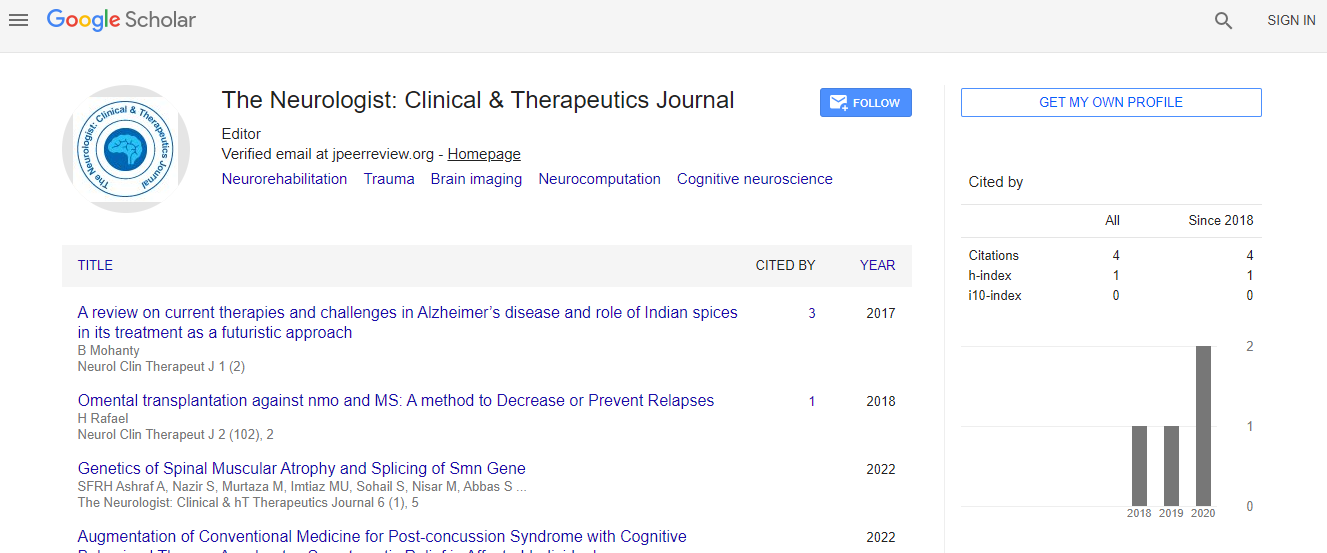Neurology Congress 2018: Altered neocortical cellular and network function after mild traumatic brain injury - Kimberle M Jacobs - Virginia Commonwealth University
*Corresponding Author:
Copyright: © 2018 . This is an open-access article distributed under the terms of the Creative Commons Attribution License, which permits unrestricted use, distribution, and reproduction in any medium, provided the original author and source are credited.
Abstract
Traumatic brain injury (TBI) is a growing global issue and might be the biggest reason for death and incapacity by 2020, as indicated by the World Health Organization. Traumatic brain injury (TBI), caused by direct blows to the head or inertial forces during relative head-brain movement, can result in long-lasting cognitive and motor deficits which can be particularly consequential when they occur in young people with a long life ahead. Much is known of the molecular and anatomical changes produced in TBI but much less is known of the consequences of these changes to neuronal functionality, especially in the cortex. Given that much of our interior and exterior lives are dependent on responsiveness to information from and about the world around us, we have hypothesized that a significant contributor to the cognitive and motor deficits seen after TBI could be changes in sensory processing. To explore this hypothesis, and to develop a model test system of the changes in neuronal functionality caused by TBI, we have examined neuronal encoding of simple and complex sensory input in the rat’s exploratory and discriminative tactile system, the large face macrovibrissae, which feeds to the so-called “barrel cortex” of somatosensory cortex. In this review we describe the short-term and long-term changes in the barrel cortex encoding of whisker motion modeling naturalistic whisker movement undertaken by rats engaged in a variety of tasks. We demonstrate that the most common form of TBI results in persistent neuronal hyperexcitation specifically in the upper cortical layers, likely due to changes in inhibition. We describe the types of cortical inhibitory neurons and their roles and how selective effects on some of these could produce the particular forms of neuronal encoding changes described in TBI, and then generalize to compare the effects on inhibition seen in other forms of brain injury. The vast greater part of wounds happen in the gentle range, ordinarily causing blackout. While a few side effects die down inside weeks, subjective challenges can a years ago and even decades. Neuronal auxiliary changes after mellow (m) TBI are notable, including diffuse axonal injury. Medicines have to a great extent concentrated on improving axonal detachment, with less spotlight on conceivable harm to neurons with flawless axons. Utilizing an all-around depicted rat model of mellow (m) TBI joined with the YFP-H transgenic strain of mice, we can distinguish the axonal status of layer V pyramidal neurons as axotomized or flawless, before entire cell fix cinch accounts. We have exhibited that both axotomized and unblemished neurons experience utilitarian changes inside two days of injury. These adjustments incorporate natural cell changes, yet in addition altered synaptic information. The axotomized and unblemished neurons follow free courses of change distinguished as ahead of schedule as one day after injury and as late as 40 days after injury. Utilizing the second subsidiary examination of the activity potential, the current thickness at axon starting section (AIS) can be isolated from that at the soma. We have as of late distributed information indicating that this current thickness is decreased at the AIS of unblemished neurons two days after injury. For axotomized neurons, there is a finished loss of the activity potential at the AIS. Shockingly, at one day after injury, 40% of unblemished neurons additionally show lost the activity potential at the AIS. These natural neuronal adjustments likely change the example of yield from flawless neurons, adequately revamping cortical practical systems. Field potential accounts show this overhauling adds to a steady increment in organize volatility even one month after injury. While most examinations have focused on the excitatory system, we have as of late stretched out our concentration to incorporate harm of neocortical inhibitory interneurons. We have discovered that inhibitory interneuron subtypes are differentially adjusted, with numerous parvalbumin inhibitory cells (PV) indicating axonal detachment. This conceivable adds to loss of inhibitory power over the AIS and cortical systems by means of PV interneurons. Using optogenetics with channel rhodopsin embedded into somatostatin inhibitory interneurons, we exhibit an upgraded yield from this sort of inhibitory cell. One aftereffect of this improvement is an expanded restraint of other inhibitory interneurons, adding to arrange disinhibition. Generally speaking we exhibit that the neocortical dim experiences complex system changes after a gentle physical issue lacking injury and that a portion of these alterations persevere for in any event one month. This significant change to the neocortical dark issue may underlie persevering subjective troubles in gentle TBI patients for which there are as of now no philosophies for distinguishing proof through clinical imaging. The amplitude of this evoked antagonism was fundamentally bigger than powers over a progression of upgrade powers at both one and multi day endurance times. Interictal-like spikes never happened in the field possible accounts from controls, yet were seen in 20-80% of boost introductions in harmed cortex. Together these outcomes propose a general increment in organize edginess and the creation of especially incredible (flawless) neurons that have both expanded inborn and synaptic sensitivity.

 Spanish
Spanish  Chinese
Chinese  Russian
Russian  German
German  French
French  Japanese
Japanese  Portuguese
Portuguese  Hindi
Hindi 